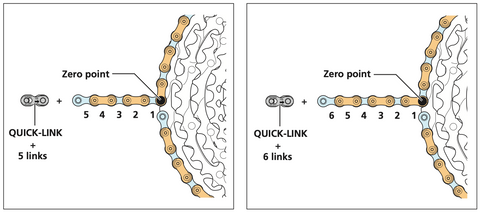
Sizing your chain for a Shimano drivetrain
Do a quick Google search on how to properly size your chain and you’ll be inundated with articles and videos on how to properly size your chain. However, many of not most don’t provide an objective way, instead focusing on subjective instructions such as talking about the chain being able to make a shift when in the largest chairing in the front and largest sprocket in the rear, or having a slight bend at each pulley as it goes through the rear derailleur when in the largest chairing in the front and largest sprocket in the rear. But how do you know it’s the ideal length to achieve the best possible shifting, since the above criteria can be satisfied with chains that could vary quite a bit in length? A properly sized chain is one of the most important factors for shifting performance and drivetrain longevity.
If you’re replacing a worn chain, and you know the previous chain was properly sized you can simply cut the new chain to the same size. However, if you’re working on a new build or maybe you have replaced your cassettes with one that has a wider range, you’ll need to size the chain properly. Changing the size of the front chainring (up or down) will also require resizing the chain.
It also very important to remember that on bikes with rear suspension the distance between the front chairing and the cassette changes as the suspension moves through its travel. As such, this needs to be taken into account when sizing the chain.
Here is how to properly size you chain for a Shimano drivetrain, taking all the guess work out of it.
Start by wrapping the chain around the largest sprocket on the cassette and the largest chainring in the front, making sure you BYPASS the derailleur. Pull the chain as tight as possible making sure it meshes properly with the teeth on the cassette and front chainring. It should look like this:

At this point you will need to find the zero point at the rear of the largest sprocket as shown below. The correct chain length is determined by adding a certain number of links to this zero point. This number will differ slightly depending on if the zero point falls on an inter or outer plate of the chain and if you will be using a Quick-Link or a connecting pin to join the chain back together.
Full Suspension bikes
NOTE: On full suspension bikes, the correct length of the chain needs to be determined with the suspension fully extended.
If using a Quick-Link to join the chain:

If using a connecting pin to join the chain:

Hardtail bikes
If using a Quick-Link to join the chain:

If using a connecting pin to join the chain:

